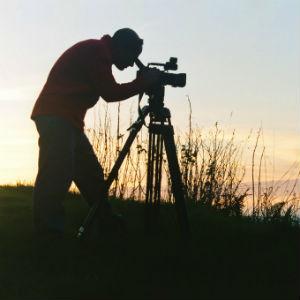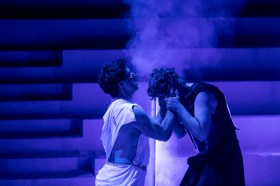The Melbourne Festival takes off this week with a program spanning the spectrum of the arts. All of the usual suspects are included in the 17-day line-up, visual arts, opera, music, dance, and theatre, but for Brett Sheehy’s fourth and final year at the helm, there’s a conspicuous new addition – film.
Noting this, we started to wonder what kind of film makes it into an arts festival? The newest celluloid chef d’oeuvre from an acclaimed auteur? An experimental, avant-garde work akin to Marcel Duchamp’s Anémic Cinéma? Upon closer inspection we found that the answer was neither. The Melbourne Festival’s inaugural film program is made up almost entirely of documentaries. Though inevitably docos that pertain to the arts in all their forms, their inclusion bubbled up another topic around the ArtsHub water-cooler – are documentaries actually art?
The instinctive response is yes. They are as painstakingly crafted as any sculpture, and take possibly even more time to produce. They’re a mixture of elements – film, sound, performance – assuring them a place alongside the most mixed-media of artworks. They share aim to illuminate and often draw upon the personal to express the universal. Often they can take on a life entirely of their own.
But then what about films like Paradise Lost: The Child Murders at Robin Hood Hills? Joe Berlinger and Bruce Sinofsky’s chronicle of the 1996 trial of Damien Echols, Jason Baldwin and Jessie Misskelley Jr, who were charged with the murder and mutilation of three second-grade boys in West Memphis, Arkansas, seems a more journalistic endeavour rather than a piece of art.
How about the work of Michael Moore? Bowling for Columbine,
To get to the bottom of this we asked the man behind the Melbourne Festival film program, BIFF Artistic Director, Richard Moore. ‘Well there’s quite a range of different styles,’ he answered when asked if documentaries should be involved in an arts festival. Speaking of the Melbourne Festival program, he outlined the different artforms that appeared as topics in the films, such as dance, music and fashion. ‘The rule of thumb was [when selecting the films] if it wasn’t an abstract piece like The Miners’ Hymns, it had to have a story or a sense of image, a sense of cinematic insight as well as being wrapped up in the story.’
Though this didn’t particularly clarify the issue, it did raise a very important point – there is quite a range of different styles for documentaries, almost as many as there are mediums in art.
While the Michael Moores of the world might be releasing the most visible examples of documentary, that doesn’t mean they’re artists. What his films do certainly contain is creativity and craft, but they don’t adhere to our definition of art, which was established not by ArtsHub, but the Oxford English Dictionary (unfortunately frameworks and definitions are required for the process of elimination):
The expression or application of human creative skill and imagination, typically in a visual form such as painting or sculpture, producing works to be appreciated primarily for their beauty or emotional power.
Now this is a somewhat limiting definition and it could be argued that there is beauty and emotional power in the work of Michael Moore – an exquisitely shot scene or touching moment captured – but his intention is not to reveal these things for their aesthetic pleasure. His intention is to lend his agenda emotional gravitas and he employs filmmaking techniques in order to do so. Bowling for Columbine doesn’t seek to understand the victims or perpetrators of that tragic crime, it shines a camera-mounted light on American gun culture and laws. Morgan Spurlock’s Supersize Me isn’t art or journalism, it’s entertainment – everyone knows McDonald’s is bad for you.
But these are mainstream examples of what is a wide and varied form. Seeking further crystallisation, we looked a little closer to home and spoke to Paul Clarke, the filmmaker behind Long Way to the Top, Bambora: The Story of Australian Surfing and Mother of Rock.
Clarke doesn’t consider himself a documentary filmmaker at all. ‘I think it just sounds so dry,’ he says. ‘I think of what I do as just filmmaking. What I do is about passion and irreverence and shared experience.’
Note that he doesn’t say it’s about reporting or documenting anything, suggesting he doesn’t consider himself a journalist. Refusing to allow a suggestion to take place of an opinion, we asked the differences between documentary and journalism. ‘I think journalists rob people of their stories in a lot of ways,’ he confides.
This isn’t just a broad swipe at unethical online trolls. Clarke was a journalist and through his experience learned that having two hundred words to tell a story in a newspaper often meant leaving things up to a sensationalist headline.
When making a documentary, the process is more organic. ‘You have to trust people and allow them to go off on their own tangent,’ he explains. ‘You’re exploring an area and you don’t know what’s important until you come back into the editing suite and then you let the film kind of dictate where it goes.’
This sounds much like a painter standing before a blank canvas. They’ve picked their paints, they’ve an image in mind, but until they’ve amassed a collection of brushstrokes, it’s anyone’s game. Speaking of a canvas, American realist Edward Hopper said, ‘I believe that the great painters, with their intellect as master, have attempted to force this unwilling medium of paint and canvas into a record of their emotions.’
Documentary is no different. Though Clarke’s films are primarily historical, the heritage of surfing and rock music amongst his subjects, he’s not offering a visual regurgitation of the textbooks, rather drawing on his own experience in hopes of achieving a shared understanding. ‘It’s what shaped me I’m really interested in understanding and playing with,’ he says. ‘They’re personal kinds of things [that he documents]. They’re what you remember and what you think are important to you and if you get that right, it’ll mean something to other people as well, but you’ve got to use yourself as that sort of yard stick.’
Isn’t this an essential quality of art? Making the personal universal, with the artist as the prism through which creativity achieves this? Clarke reinforces this notion, ‘I imagine what I’m doing is playing music on a collective memory. If you can appreciate the zeitgeist around us, of all the people that are thinking and have experienced something, it all means something to them and what you’re doing is you’re shaping that and you’re kind of grooving on it. It’s trying to find the essence of things.’
Even the most journalistic of documentary makers hope for something other than strict reportage. Czechoslovakian filmmaker Petr Lom’s doco Back to the Square, screening at the 2012 Antenna Documentary Festival, follows the lives of ordinary Egyptians in the aftermath of the January 25 revolution. While he hopes that the audience ‘might see the world as a bit… smaller… and maybe even imagine it is a place where they have friends – the characters they’ve spent time with in the film,’ his first response to what he wishes for people to feel is, ‘Awe. Magic. Life changing poetry.’ This suggests that he isn’t merely documenting the consequences of regime change; he has an artistic intention achieved through fact.
None of this is to even mention the ways that documentaries are constructed as an artefact in themselves. Clarke indicates the three colours in his filmmaking palette as interviews, archival footage and script. This is true for many documentaries, but then consider something like Naeem Mohaiemen’s doco The Young Man Was, Part 1: United Red Army. Rather than interviews, Monhaiemen uses TV recordings and text to explore the relationship between a hijacker in the Japanese Red Army negotiating with a military commander for the releases of hostages aboard Japan Airlines Flight 472. Such considered construction reminds more of a Dadaist collage than a documentary.
The definition of a documentary is that it is a television, film or radio program that provides a factual report on a particular subject. But like the above definition of art, that discounts the ambitions of filmmakers and their achievements. Just because a documentary is commonly founded on fact, doesn’t mean it represents a concrete reality, it may indicate something beyond its subject.
When asked who his favourite filmmaker is, Antenna Documentary Festival programmer, Richard Welch mentions Steve James’ 1994 doco, Hoop Dreams. ‘His films tend to centre on such strong central characters telling their stories…’ he says. ‘And yet in the same breath, often these characters serve as metaphors, helping to emphasise wider issues about our society.’
Clarke reiterates the ability of documentary to reveal more than just its subject when talking about his latest project, a two-part series on Gough Whitlam. ‘I kind of see [Whitlam] as this songwriter, this ideas powerhouse, someone that came up with a great concept album… and the record company kind of came down on him,’ Clarke explains while laughing. ‘It’s a perfect fable for our contemporary political situation and it’s really fascination looking at Whitlam against the backdrop of what we’ve got today.’
In this manner a documentary, purportedly historical in nature, intends to brighten our understanding of society through a creative exercise – the filmmaking process.
So is documentary art because the two share similar qualities of creativity, imagination, craft and illumination? Not necessarily. Invariably it comes down to the skill of the filmmaker, their intentions and if it’s even meant to be art. I can’t imagine that Morgan Spurlock thinks of himself as an artist, or that John Alvin only ever considered himself a maker of movie posters. Not every painting is a work of art, nor is every documentary, but there’s certainly enough masterpieces out there to forgive all the stick figures and Supersize Mes.
Five documentaries not to miss
The Fog of War by Errol Morris.
The Ambassador by Mads Brügger.
Life in Movement by Bryan Mason & Sophie Hyde.
Hail the New Puritan by Charles Atlas.
Paradise Lost by Joe Berlinger and Bruce Sinofsky.
Do you agree? Leave a comment below
Almost every documentary filmmaker or festival programmer we speak to mentions Errol Morris’ The Fog of War






